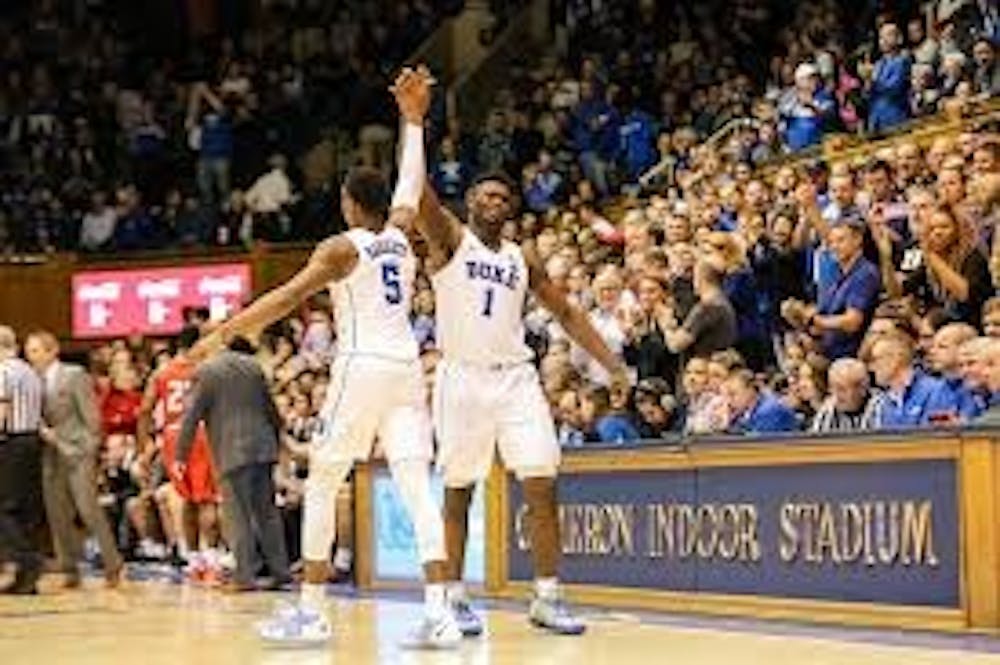It was set to be one of the most anticipated games in college basketball’s biggest rivalry. Tickets for the Feb. 20 University of North Carolina-Duke game at Cameron Indoor Stadium were selling for over $4,000. And it was all thanks to the excitement surrounding freshman Duke forward Zion Williamson.
At six feet, seven inches and 285 lbs, Williamson has been in the national spotlight since high school and is projected to be the first pick in the NBA draft this year. Starting alongside Williamson for Duke are four other freshmen, all of whom were top-15 recruits coming out of high school. Combined, No. 3 Duke and No. 8 North Carolina’s rosters boast four of the top five players on that list. In all, the rivalry game was positioned to be one of the most entertaining of the year.
But it never came close to meeting expectations. Under 40 seconds after tip-off, Williamson planted his foot on defense. He broke through his left Nike shoe, fell backwards, and sprained his right knee. Duke would never lead in the game. The Blue Devils were routed by the Tar Heels 88–72. In the absence of Williamson’s strong frame, 62 of UNC’s points came from the paint.
Unfortunately for North Carolina, conversations surrounding the game shifted quickly from the team’s unexpected dominance to the repercussions of Zion’s injury. First, the injury posed a difficult problem for Nike, whose stock dropped by 1.37% when it opened the next morning. It also may cost Nike the opportunity for a shoe deal with Williamson post-college. Second, Williamson’s knee sprain has led to some adjustment difficulties for Duke, who has lost two of its last three games in his absence. But most important is the question of whether Williamson will ever return to Duke – and how his situation relates to the larger issue of compensating college athletes.
Williamson is still projected to be the top pick in the draft. But if he returns and injures himself again, his draft stock may go down, potentially costing him millions of dollars. Thus, the media world is embroiled in a fierce debate about whether Williamson should return and help his team try to win a championship or whether he should shut down for the rest of the season and preserve his status.
This also begs the question of whether Williamson’s case shows that college athletes should be paid. The amount of money that top players like Williamson give to their schools, the NCAA, and the networks that broadcast them is far greater than the compensation they receive through scholarships. Additionally, the money Williamson will likely gain in the NBA dwarfs the money it costs for a year of college, so the argument that he is already compensated or that he owes something to the school does not really hold up.
A different argument for Williamson’s compensation is that Duke paid for a policy called the Loss of Value provision, which would mean that if he were to fall in the draft, Williamson could be paid up to $8 million dollars to make up for the loss in salary. Ronnie Kaymore, the CEO of Kaymore Sports Risk Management and a specialist in advising athletes for insurance injury protection, does not think that this is nearly enough. Kaymore believes that with an $18 million rookie contract, plus the possibility of another $30-50 million in endorsements, Williamson is worth up to seven times as much as Duke has insured him for.
On ESPN, Jalen Rose advocated for Williamson to stay at Duke for another reason. Since the nature of the injury was non-contact, he said, Williamson would have the same likelihood of repeating that same injury while training for the draft. Rose maintains that it might as well help to get more playing experience in. While this is true, the likelihood of Williamson suffering a more serious injury increases significantly if he were to play more games this season, especially with the physical nature of his playing style.
It is true that Williamson is a rare case. He will likely have the chance to make more money in his career than most or all of his current peers in college sports. Increasingly, however, we have seen similar decisions made by college football athletes, who have chosen not to participate in their schools’ bowl games. 2016 was a particularly controversial year for this, as players like Leonard Fournette, Christian McCaffrey, and Jabrill Peppers all chose to skip their games and protect their draft status for the NFL.
Just as Charles Barkley criticized those who would want Williamson to shut down, arguing that basketball players should play for the love of the game and value their education, football players were similarly criticized in 2016 by older players in the media for either not representing their teammates well or not being ready for the contact of professional sports.
That same year, Jabrill Peppers’ teammate at Michigan, tight end Jake Butt, had a similar opportunity to either play or shut down in a bowl game against Florida State. He chose to play, but ended up tearing his ACL in the game. Considered a top player in his position for the 2017 draft, Butt fell from being a potential first round pick to a fifth-round pick. Two years later, Butt is currently healing from his third torn ACL and has only played in three NFL games.
For a player still trying to better his position in the draft, coming back to play more games might be a good decision. But Williamson – and other players who have already had enough chances to prove their worth – deserve the right to stay healthy and earn money to improve their lives and the lives of their families. Considering how much profit they generate and how little they see is worrying enough. Who are we to tell these athletes to risk their futures for our entertainment, their schools, or the NCAA when they have already contributed so much?









